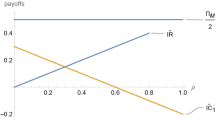Abstract
This study analyzes the information content of the financial reports of the management-controlled firm in an efficient market. The firm's disclosure fulfills two roles: it is the basis of the principal-agent contract—stewardship role, and it is an input to the market price informativeness (decision making) role. Optimal disclosure is derived as the outcome of the firm's owner-manager-potential buyer game. The seller and the buyer maintain principal-agent relationships with the manager, who alone observes verifiable and unverifiable information on the value of the firm. The market's price of the firm, as well as the manager's compensation, depend on the firm's reports. The firm's owner directs the manager to report verifiable information, at least, (due to the threat of coalition forming) and stewardship information, at most. The market's reaction to the financial reports depends on the information available to the market prior to their release.
Similar content being viewed by others
References
Akerlof, George A., “The Market for ‘Lemons’: Quality Uncertainty and the Market Mechanism.”Quarterly Journal of Economics 84, 488–450, (1970).
Ball, R. and P. Brown, “An Empirical Evaluation of Accounting Income Numbers.”Journal of Accounting Research 6, 159–178, (1968).
Bernheim, B.D., B. Peleg, and M.D. Whinston, “Coalition-Proof Nash Equilibria. I. Concepts.”Journal of Economic Theory 42, 1–12, (1987).
Darrough, M.N. and N.M. Stoughton, “Financial Disclosure Policy in an Entry Game.”Journal of Accounting and Economics 12, 219–243 (1990).
Dye, Ronald A., “Disclosure of Nonproprietary Information.”Journal of Accounting Research 23, 123–145, (1985).
Dye, Ronald A., “Earnings Management in an Overlapping Generations Model.”Journal of Accounting Research 26, 195–235, (1988).
Fudenberg, Drew and Jean Tirole, “A ‘Signal-Jamming’ Theory of Predation.”Rand Journal of Economics 17, 366–376, (Autumn 1986).
Gjesdal, Froystein, “Accounting for Stewardship.”Journal of Accounting Research 19, 208–231, (1981).
Gonedes, Nicholas J., “Information Production and Capital Market Equilibrium.”The Journal of Finance 30, 841–864, (1975).
Green, Edward J., “On the Difficulty of Eliciting Summary Information.”Journal of Economic Theory 32, 228–245, (1984).
Okuno-Fujiwara, Masahiro, Andrew Postlewaite, Kotaro Suzumura, “Strategic Information Revelation.”The Review of Economic Studies 57, 25–48, (January 1990).
Ronen, Joshua, “The Dual Role of Accounting: A Financial Economic Perspectives.”Handbook of Financial Economics. James L. Bicksler, ed., Amsterdam, North-Holland Publishing Company, 1979.
SFAC 1–6, 1978, 1980, 1984, 1985.
Verrecchia, Robert, “Discretionary Disclosure.”Journal of Accounting and Economics, 77–90, (1983).
Wagnerhofer, A., “Voluntary Disclosure with Strategic Opponent.”Journal of Accounting and Economics 12, (1990).
Author information
Authors and Affiliations
Rights and permissions
About this article
Cite this article
Ronen, J., (Lewinstein) Yaari, V. The disclosure policy of the firm in an efficient market. Rev Quant Finan Acc 3, 311–324 (1993). https://doi.org/10.1007/BF02406994
Issue Date:
DOI: https://doi.org/10.1007/BF02406994




